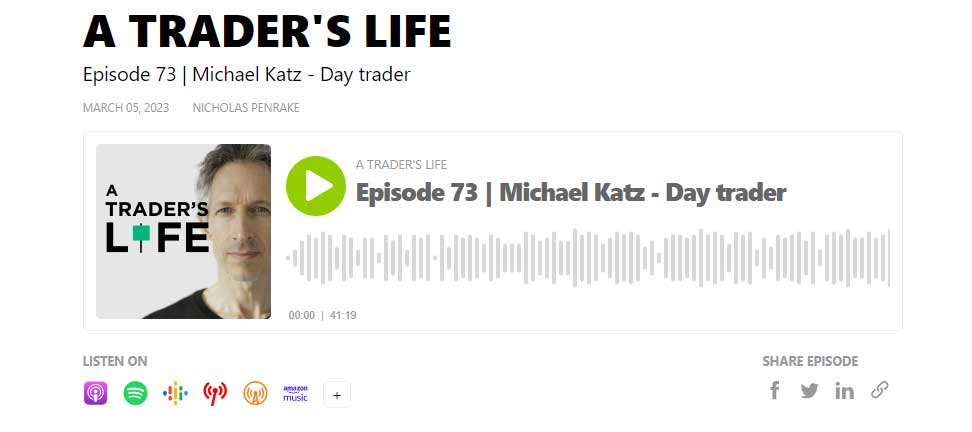
In this episode of “A Trader’s Life” podcast, the host – Nicholas Penrake interviews Michael Katz, a day trader from Israel who has been trading stocks and futures for 15 years. Katz is also the CEO of ‘Trade the Pool’, a prop firm for stock traders, based in Israel.
The Beginning
Michael explains how he got interested in trading, when his back-then-girlfriend introduced him to the book “Rich Dad Poor Dad” by Robert Kiyosaki, which helped him understand the stock market. Katz was also a gamer when he was younger, which he thinks helped him with trading as he was able to apply the skills he learned from gaming to the financial market. He explains that he only day trades and looks at one-minute charts, as he enjoys the feeling of watching the chart move in real-time and making quick decisions. Katz advises new traders not to trade on their own money and to detach their emotions from their trades, as this can lead to bad decisions. He also shares some tips on how to control stress, such as trading with other people’s money or starting small.
The Big loss
Michael also tells Nicholas about a time when he lost $10K in a trade and had to take a break for two weeks to reflect on what went wrong both mentally and technically. He learned that he needed to be tighter with his risk management and became more disciplined in his trading strategy. He used to trade stocks without focusing on a specific sector but rather trading what moves at the moment based on news and volume. They source his news from the trading platform he uses or the trader pool. Nowadays, he is doing more scalping and holding his positions for about 20-30 minutes. Michael also trades with leverage, up to 1:100 or 1:50, using the trading pool.
Main Setups
Next, Nicholas heard about the two main setups Michael uses for scalping: opening drive, where he shorts stocks when it drops below the first support level, and reverse setups, where he buys a stock after it reaches a major support level. He also uses two indicators: MACD to find negative or positive divergences, and the 200 and 420 exponential moving averages (EMAs) to identify support and resistance levels. Michael explains how he tried different indicators before settling on their current choice. He used to trade four or five stocks simultaneously using a software that connects to his Interactive Broker account to manage trades, but he now focuses on running his professional firm, and only makes one or two trades per session.
Algo Trading
Referring to his experience with algorithmic trading, Michael tells how he developed a system with a friend that worked well on a demo but resulted in losses when they used real money. While he has a mathematical background and can code, he has not pursued systematic trading further because much of his trading involves managing trades, which is difficult for a computer to execute.
Emotional Trading
He describes his approach to risk management and adding to positions, scaling his position and not risking more than they can afford to lose. He notes that fear was one of the most common problems he faced when he started trading, specifically the fear of losing money. He also discusses his impulsive tendencies and the fear of missing out, which led to exiting trades too early and not maximizing potential profits. Michael learned to reduce his risk and to wait for indicators before adding to positions, rather than chasing after a trade.
Conclusion
Overall, Michael’s approach to trading involves managing risk and being patient with trades, rather than relying solely on algorithms.
If you liked this post make sure to share it!





